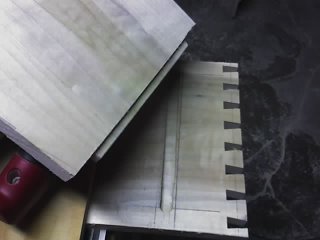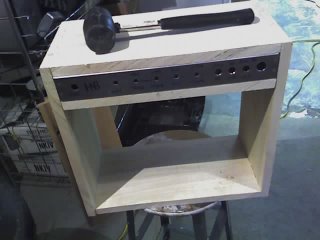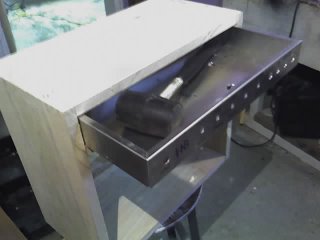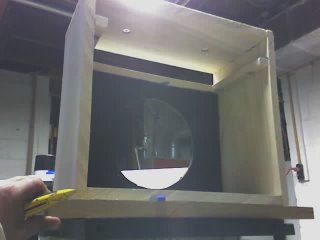 With the dovetails routed out, now I need to build a shelf to hold the amp chassis. Here you can see my thumb holding the chassis inside the empty shell that will become the combo amp. My desire is to build a cabinet that is structurally solid without fasteners. Building a shelf right in will make it very solid.
With the dovetails routed out, now I need to build a shelf to hold the amp chassis. Here you can see my thumb holding the chassis inside the empty shell that will become the combo amp. My desire is to build a cabinet that is structurally solid without fasteners. Building a shelf right in will make it very solid. In furniture-land, I think this would be called a mortise and tenon joint. I do not think I have an interest in building furniture - but I can really get into the allure that it holds. Of course, I would be the type of hobbyist that uses a router to do such things, since my real hero is Norm Abrams (and not Roy Underhill). Now you can see how integrating dovetails, mortise/tenon, and dado joints makes a strong structure for such a small little box.
In furniture-land, I think this would be called a mortise and tenon joint. I do not think I have an interest in building furniture - but I can really get into the allure that it holds. Of course, I would be the type of hobbyist that uses a router to do such things, since my real hero is Norm Abrams (and not Roy Underhill). Now you can see how integrating dovetails, mortise/tenon, and dado joints makes a strong structure for such a small little box. I like this picture, it really shows how rough my carpentry skills are. Note that the front of the cabinet does not really line up on the corners. The funny thing is that some 60-grit sandpaper will clean that right up. I have been told by more hardcore enthusiasts that sandpaper should never really touch fine furniture. Well, luckily a guitar amp could not be considered "fine." Anyhow, here you can see how the shelf will hold the chassis.
I like this picture, it really shows how rough my carpentry skills are. Note that the front of the cabinet does not really line up on the corners. The funny thing is that some 60-grit sandpaper will clean that right up. I have been told by more hardcore enthusiasts that sandpaper should never really touch fine furniture. Well, luckily a guitar amp could not be considered "fine." Anyhow, here you can see how the shelf will hold the chassis. Okay, maybe building some furniture would be fun. Here is my combo amp serving as an end table with a drawer! I will actually need to cut a bit of the shelf out, though, because some components of the amp (important stuff like transformers and tubes!) will hang down. That is what the picture below shows.
Okay, maybe building some furniture would be fun. Here is my combo amp serving as an end table with a drawer! I will actually need to cut a bit of the shelf out, though, because some components of the amp (important stuff like transformers and tubes!) will hang down. That is what the picture below shows. Luckily, I remembered to cut a dado joint near the front of the shelf to receive the speaker baffle. It would have been harder because the cut on the dado into such a delicate piece later. Here you can see the backside of the cabinet starting to look like my "plans." The speaker baffle is sitting within a groove (dado) cut into three of the cabinet sides, and the bottom of the shelf. The speaker baffle is just 1/2" pine plywood. This would be a no-no if I were building a larger (louder) amp because regular pine plywood has thick veneers, and possible voids within it. The real amp-makers try to use birch plywood that cabinet makers use. If I build anything louder than 5-6 watts, then I will keep that in mind.
Luckily, I remembered to cut a dado joint near the front of the shelf to receive the speaker baffle. It would have been harder because the cut on the dado into such a delicate piece later. Here you can see the backside of the cabinet starting to look like my "plans." The speaker baffle is sitting within a groove (dado) cut into three of the cabinet sides, and the bottom of the shelf. The speaker baffle is just 1/2" pine plywood. This would be a no-no if I were building a larger (louder) amp because regular pine plywood has thick veneers, and possible voids within it. The real amp-makers try to use birch plywood that cabinet makers use. If I build anything louder than 5-6 watts, then I will keep that in mind.--gh
No comments:
Post a Comment